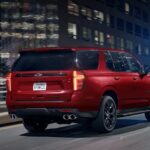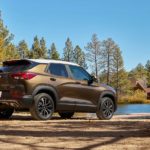Today, many SUVs are capable of towing some serious weight. Road trippers who want to take their accommodations with them but don’t want to buy an RV are taking advantage of such SUVs because it lets them continue to drive the vehicle they’re comfortable in while having a small camper or trailer in tow. Another perk of using an SUV to trailer something is that you can take your mobile sleeping quarters to your destination, unhitch it, and then use your SUV as you normally would to drive around and explore your destination. Driving an RV means you’re stuck with that massive vehicle, which can be limiting in terms of where you can go once you reach your destination.
If you’ve recently purchased a used Chevy Traverse for sale, a Honda Pilot, a Nissan Pathfinder, or one of the other large SUVs with solid towing abilities, you might be planning some road trips with a hefty load trailering behind your SUV. While using a large SUV to tow does mean you get to stay behind the wheel of a vehicle style to which you’re accustomed, towing does require extra precautions and slightly different behaviors. Properly preparing your SUV and trailer for long trips, as well as driving with a camper in tow, can take some getting used to. Once you get the hang of it, you’ll be ready to road trip it across the country with confidence and a camper behind you.
Preparing Your Trailer
The first thing you’ll need to do is prepare your SUV and trailer for your trip. This will mean knowing exactly how large your trailer can be and how much you can put inside it. If you’re new to this process, there are a few main labels you want to look for. These are: 1) the gross vehicle weight rating, 2) the gross combined weight rating, and 3) the trailer tongue weight. You’ll know the maximum trailer weight for your SUV when you purchase it. However, know that if you hope to utilize it, you’ll typically need factory-installed trailering equipment. Below is a definition of those important terms.
Gross vehicle weight rating refers to how much your vehicle can safely weigh when just the SUV itself is loaded up with passengers and all of their belongings. So, the trailer is not a part of this figure.
Gross combined weight rating refers to the total safe weight of your SUV, passengers, and their belongings, along with the weight of the trailer/camper plus all of its contents.
Trailer tongue weight refers to the downward force at the junction where the trailer connects to your SUV. Generally, this should not exceed 10 to 15 percent of the gross trailer weight (that’s the total weight of just the trailer with its cargo). Do not attempt to exceed these weight limits. Doing so can pose a safety hazard and can also put you at risk of facing significant fines. Remember, you will likely have to go through scales on your road trip, and if you don’t pass the weigh-in, you could pay the price.
On the topic of those scales, you can use them to your advantage before you hit the road. Find a local public scale and visit it when your trailer is attached to your SUV and everyone and everything is loaded up. There, you can see if you’re following weight regulations or need to leave some stuff behind (or maybe a passenger – sorry to your in-law who you secretly didn’t want to bring along anyway!)
Planning Your Trip
One thing that can take some getting used to is the fact that you’ll likely need to adjust your route based on the fact that you are trailering. In the past, when you’ve been driving just an SUV with nothing behind it, you’ve probably noticed posted signs about height or width restrictions when going under bridges or through tunnels. Those didn’t apply to you before, but they do now.
If you will be traveling to places you’ve never been before, it’s a good idea to use Google Street View and get a close-up look at some of your planned routes. You might have to adjust your route if it’s taking you down a narrow road or under any low bridges because your trailer might not fit. In general, you’ll also thank yourself for avoiding busy city streets or similar congested areas. Other drivers aren’t typically very generous when it comes to letting huge SUVs with trailers in tow cut in front of them or change lanes during rush hour.
You should also plan for your trip to take longer than it would without a trailer. Some people say you should add an hour or two to whatever your GPS is saying (for drives ranging from five to six hours). Remember, you must drive much more slowly when you’re trailering and might be forced to take a different route than you would without a trailer. (Pro tip for parents: make sure your kids have everything they need to stay entertained for the longer drive).
Also, be sure to plan your route for minimum stops. Getting on and off freeway ramps when trailering poses an extra challenge, as does finding a spot in a parking lot for your SUV plus trailer. The fewer stops you make, the more you’ll thank yourself.
Being a Safe Driver While Trailering
You can do a few things to be a safe driver when you’re towing in your SUV. One thing starts in the shopping process and involves looking for features that can help you drive safely when trailering. The 2020 Traverse, for example, has an available trailer hitch view on its camera to help you better see what’s happening back there when trailering. Another great feature on the Traverse to utilize is the available tow/haul mode. It automatically makes adjustments to the transmission to help it get into the right gear when towing.
You can also add extended side mirrors to your vehicle. These stick out further than the standard mirrors your vehicle will come with and can help you see behind and around the trailer. Remember, if your camper is wide, it will block your view and make it harder to see vehicles in your rear. Before even hitting the road, ensure all electrical connections are working. This means ensuring your trailer’s brake lights and turn signals are working so you can communicate with other drivers on the road. Finally, consider practicing towing around your town before going on a long trip. You can do this on your street if it’s quiet or find an empty parking lot to do it in.
Towing a Trailer With Your SUV Opens up a World of Possibilities
Many drivers don’t feel comfortable driving an RV or simply don’t have the budget (or storage space) for one. That doesn’t mean they’re out of options when it comes to taking your accommodations with you on a road trip. If you get an SUV with a good towing ability, you can bring a camper with you. That means you get to drive the vehicle you already like driving and don’t need to pay for a hotel or rental when you get to your destination.
It is important to recognize that towing a camper changes the experience of driving an SUV. Almost nobody is great at it right away, and there are some tips even the most seasoned towers follow to remain safe. Do the same, and you’ll enjoy a fun and safe road trip with a camper in tow.






